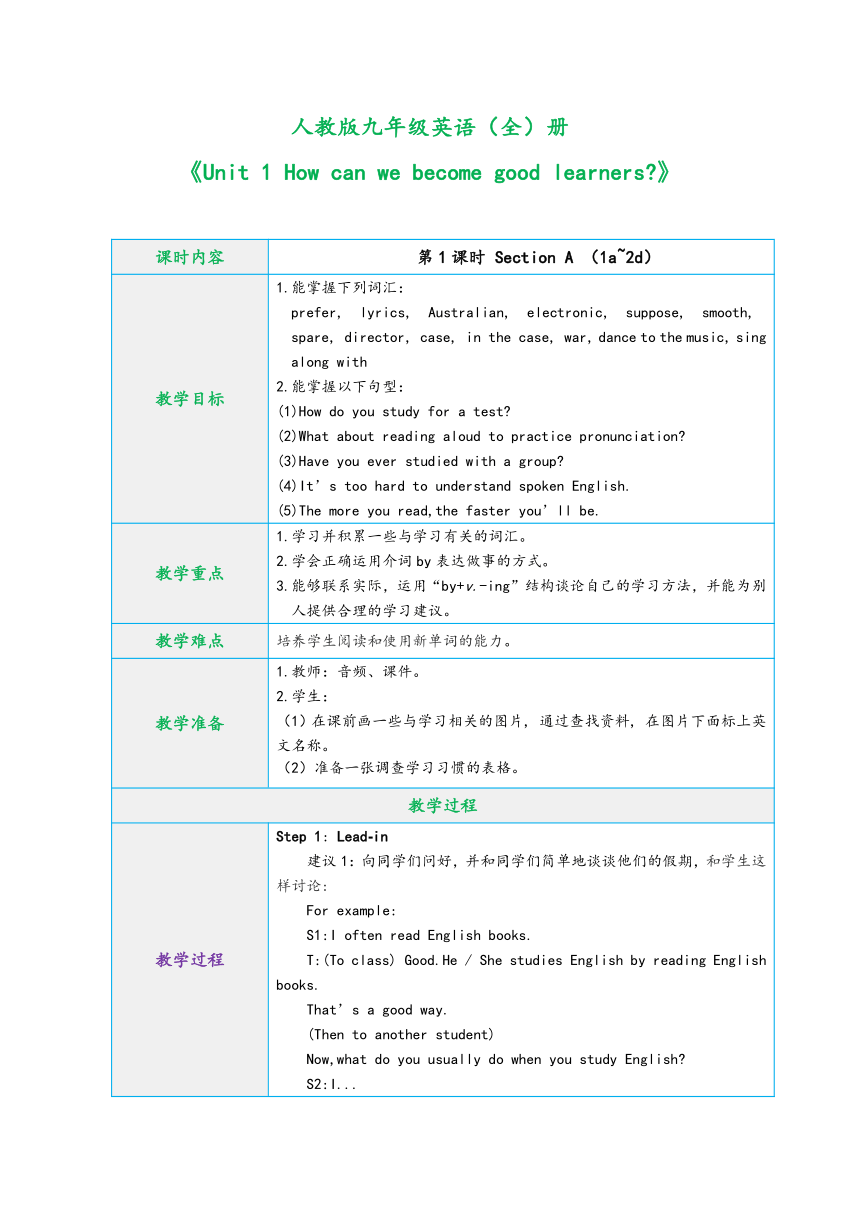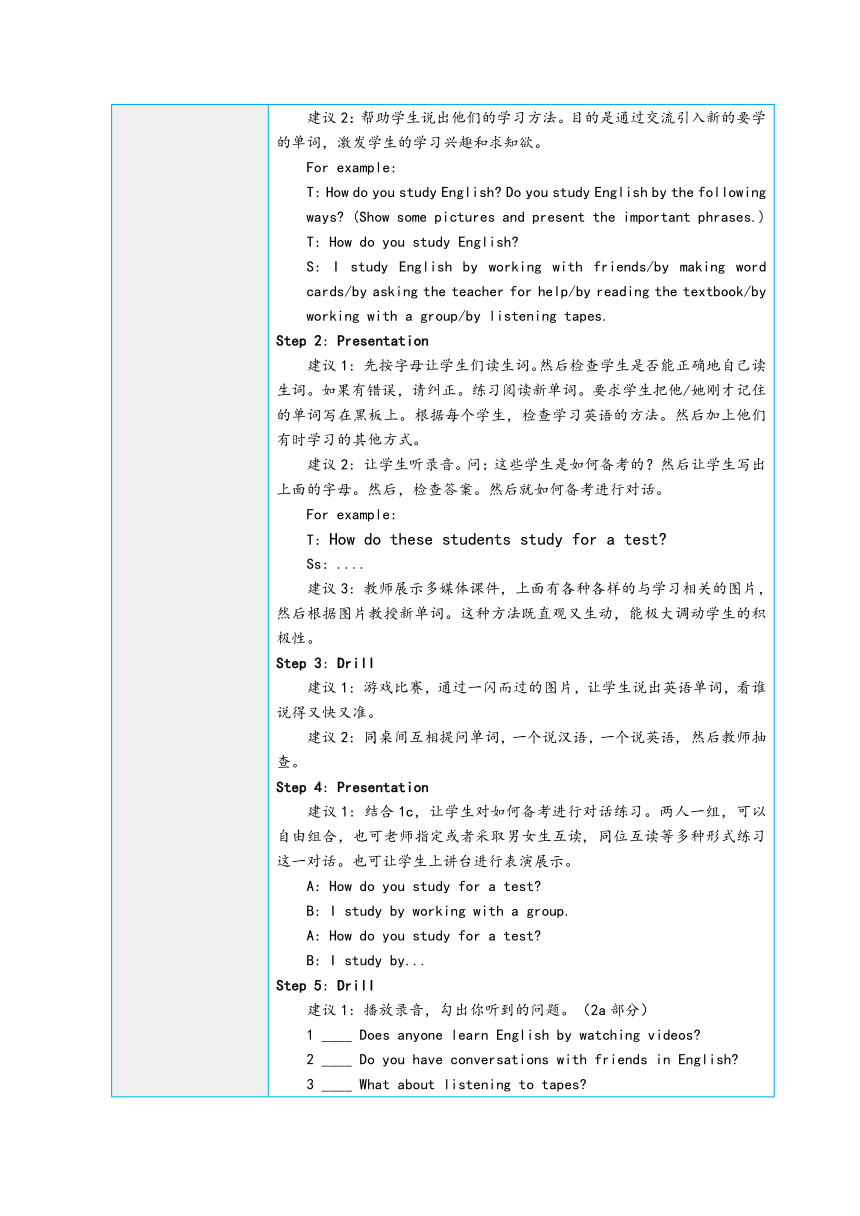人教版九年级英语(全)册 Unit 1 How can we become good learners?第1课时 Section A (1a-2d)教学设计(表格式)
文档属性
| 名称 | 人教版九年级英语(全)册 Unit 1 How can we become good learners?第1课时 Section A (1a-2d)教学设计(表格式) |  | |
| 格式 | docx | ||
| 文件大小 | 23.1KB | ||
| 资源类型 | 教案 | ||
| 版本资源 | 人教新目标(Go for it)版 | ||
| 科目 | 英语 | ||
| 更新时间 | 2024-05-29 22:36:32 | ||
图片预览


文档简介
人教版九年级英语(全)册
《Unit 1 How can we become good learners 》
课时内容 第1课时 Section A (1a~2d)
教学目标 1.能掌握下列词汇: prefer, lyrics, Australian, electronic, suppose, smooth, spare, director, case, in the case, war, dance to the music, sing along with 2.能掌握以下句型: (1)How do you study for a test (2)What about reading aloud to practice pronunciation (3)Have you ever studied with a group (4)It’s too hard to understand spoken English. (5)The more you read,the faster you’ll be.
教学重点 1.学习并积累一些与学习有关的词汇。 2.学会正确运用介词by表达做事的方式。 3.能够联系实际,运用“by+v.-ing”结构谈论自己的学习方法,并能为别人提供合理的学习建议。
教学难点 培养学生阅读和使用新单词的能力。
教学准备 1.教师:音频、课件。 2.学生: (1)在课前画一些与学习相关的图片, 通过查找资料, 在图片下面标上英文名称。 (2)准备一张调查学习习惯的表格。
教学过程
教学过程 Step 1: Lead in 建议1:向同学们问好,并和同学们简单地谈谈他们的假期,和学生这样讨论: For example: S1:I often read English books. T:(To class) Good.He / She studies English by reading English books. That’s a good way. (Then to another student) Now,what do you usually do when you study English S2:I... 建议2:帮助学生说出他们的学习方法。目的是通过交流引入新的要学的单词,激发学生的学习兴趣和求知欲。 For example: T: How do you study English Do you study English by the following ways (Show some pictures and present the important phrases.) T: How do you study English S: I study English by working with friends/by making word cards/by asking the teacher for help/by reading the textbook/by working with a group/by listening tapes. Step 2: Presentation 建议1: 先按字母让学生们读生词。然后检查学生是否能正确地自己读生词。如果有错误,请纠正。练习阅读新单词。要求学生把他/她刚才记住的单词写在黑板上。根据每个学生,检查学习英语的方法。然后加上他们有时学习的其他方式。 建议2: 让学生听录音。问:这些学生是如何备考的?然后让学生写出上面的字母。然后,检查答案。然后就如何备考进行对话。 For example: T: How do these students study for a test Ss: .... 建议3: 教师展示多媒体课件,上面有各种各样的与学习相关的图片,然后根据图片教授新单词。这种方法既直观又生动,能极大调动学生的积极性。 Step 3: Drill 建议1: 游戏比赛,通过一闪而过的图片,让学生说出英语单词,看谁说得又快又准。 建议2: 同桌间互相提问单词,一个说汉语,一个说英语, 然后教师抽查。 Step 4: Presentation 建议1: 结合1c,让学生对如何备考进行对话练习。两人一组,可以自由组合,也可老师指定或者采取男女生互读, 同位互读等多种形式练习这一对话。也可让学生上讲台进行表演展示。 A: How do you study for a test B: I study by working with a group. A: How do you study for a test B: I study by... Step 5: Drill 建议1: 播放录音,勾出你听到的问题。(2a部分) 1 ____ Does anyone learn English by watching videos 2 ____ Do you have conversations with friends in English 3 ____ What about listening to tapes 4 ____ What about reading aloud to practice pronunciation 5 ____ Have you ever studied with a group 让同学们进行作答,然后与同伴进行答案的检查。 Answers: 1, 2, 4, 5 建议2: 再听一遍。将下面的每个答案与上面的一个问题相匹配。(2b部分) a. Yes, I have. I’ve learned a lot that way. b. Oh, yes. It really improves my speaking skills. c. I do that sometimes. I think it helps. d. No. It’s too hard to understand spoken English. Answers: d, b, c, a 让同学们进行作答,然后与同伴进行答案的检查。表扬全做对的同学。 建议3: 角色扮演对话。结合2d,让学生进行对话练习。两人一组,可以自由组合,也可老师指定或者采取男女生互读, 同位互读等多种形式练习这一对话。也可让学生上讲台进行表演展示。(2c,2d部分) For example: (2c) A: Do you learn English by watching movies B: Yes, it’s a very interesting way. C: No, it’s too hard to understand spoken English. For example: (2d) Jack: Annie, I’m a little nervous. I have to finish reading a book and give a report next Monday. Annie: That doesn’t sound too bad. Jack: But I’m a very slow reader. Annie: Just read quickly to get the main ideas at first. Don’t read word by word. Read word groups. Step 6: Language points 【知识讲解】 1.how 引导的疑问句 how 引导的特殊疑问句可用来询问做事的方式或手段,意为“怎样”。 —How do you study for a test —I study by working with a group. ——你是怎样学习来准备考试的 ——我是通过小组合作来学习的。 “by + v.-ing”常常表示手段、方式或方法,可以用来回答“how”引导的特殊疑问句。 2.介词by的用法 by作为介词,用法很多。请仔细观察下面的例句,分析by的用法,然后补全结论部分所缺的内容。 【例句】 (1)Come and sit by us. (2)Peter goes to work by bus every day. (3)Tony will come back by 10:00 pm. (4) English is spoken by lots of people. (5) My brother studies history by working with a group. 【结论】 (1) by可表示位置,“在……旁边”。也有“从……旁边(经过)”之意。 (2) by可表示交通、传递等的方式。 (3) by可表示时间,“到(某时)之前;不迟于”。 (4) by可用于构成(2) 被动语态,“被,由”。 (5) by可表示方式或手段,“by + V.-ing形式”结构在句中作方式状语,“通过……方式(方法)”或“借助……手段”。 3.word by word 逐字地 Don’t translate the sentences into Chinese word by word. 不要把句子逐字翻译成汉语。 类似的短语还有:day by day 一天天地 one by one 逐个 He is getting older day by day.他一天天地长大。 4.The+比较级....,the+比较级...;表示“越……,就越……”。 The more careful you are,the fewer mistakes you will make. 你越细心,你出错就越少。 The higher the mountain is,the thinner the air will be. 山越高,空气就越稀薄。 5.it作形式主语 it作形式主语时, 一般不定式短语是真正的主语。一般构成的句型为: It’s+too+adj.+ (for sb.)+to do sth. 意思是“(对某人来说)做某事是……的”。 I’s too important to keep healthy.保持健康太重要了。 It’s difficult for him to learn two languages. 对他来说学习两种语言是困难的。 Step 7: Task 建议:仔细阅读2d的具体概念。用2d中的信息填空。 For example: ProblemsSolutionsA very slow reader.Just read 1.________________ to get 2.________________. Don't read 3.______________. Read 4.______________.Don't understand many of the words.Try to guess a word's meaning 5.__________________ before and after it.
Answers:1.quickly 2.the main ideas at first 3.word by word 4.word groups 5.by reading the sentences Step 8: Summary 建议:让学生自己总结本节课主要学习了什么,还有哪些疑惑?教师可作补充。 For example: 本节课我们主要学习了表示与学习相关的单词以及表达学习方式的句型: How do you study English I study by working with friends/by watching English movies/ by making word cards/by reading the textbook/ by listening to tapes/ by asking the teacher for help/by reading aloud/by...这些句型是我们这一节课的重点, 也是整个单元的重点句型。我们会在以后的学习中继续学习和巩固。
课堂作业 1.口头作业: 朗读听力材料1c和2d。 2.书面作业: 调查你的同学的学习方式。 How do you study ... ClassmatesChineseMathsEnglishABCD
板书设计 Unit 1 How can we become good learners Section A(1a~2d)
教学反思 —How do you study English —I study English... by working with friends by making word cards by reading the textbook by listening to tapes by asking the teacher for help
这是单元的第一个课时。因此,让学生知道他们将在本单元学习什么以及他们的学习目标是很重要的。一开始,教师应该教授“by+ doing”的主要结构,并让学生在听和说中进行练习。教师应鼓励学生多练习使用目标结构。 在这一时期,出现了更多的新词和短语。老师应该提供更多的听力和口语练习,鼓励学生更多地参与。在阅读部分,学生可以在自然语言中使用目的语进行更多的练习。在这一部分,老师应该教学生一个阅读策略——SQ4R(调查、提问、阅读、记录、背诵、复习)。
《Unit 1 How can we become good learners 》
课时内容 第1课时 Section A (1a~2d)
教学目标 1.能掌握下列词汇: prefer, lyrics, Australian, electronic, suppose, smooth, spare, director, case, in the case, war, dance to the music, sing along with 2.能掌握以下句型: (1)How do you study for a test (2)What about reading aloud to practice pronunciation (3)Have you ever studied with a group (4)It’s too hard to understand spoken English. (5)The more you read,the faster you’ll be.
教学重点 1.学习并积累一些与学习有关的词汇。 2.学会正确运用介词by表达做事的方式。 3.能够联系实际,运用“by+v.-ing”结构谈论自己的学习方法,并能为别人提供合理的学习建议。
教学难点 培养学生阅读和使用新单词的能力。
教学准备 1.教师:音频、课件。 2.学生: (1)在课前画一些与学习相关的图片, 通过查找资料, 在图片下面标上英文名称。 (2)准备一张调查学习习惯的表格。
教学过程
教学过程 Step 1: Lead in 建议1:向同学们问好,并和同学们简单地谈谈他们的假期,和学生这样讨论: For example: S1:I often read English books. T:(To class) Good.He / She studies English by reading English books. That’s a good way. (Then to another student) Now,what do you usually do when you study English S2:I... 建议2:帮助学生说出他们的学习方法。目的是通过交流引入新的要学的单词,激发学生的学习兴趣和求知欲。 For example: T: How do you study English Do you study English by the following ways (Show some pictures and present the important phrases.) T: How do you study English S: I study English by working with friends/by making word cards/by asking the teacher for help/by reading the textbook/by working with a group/by listening tapes. Step 2: Presentation 建议1: 先按字母让学生们读生词。然后检查学生是否能正确地自己读生词。如果有错误,请纠正。练习阅读新单词。要求学生把他/她刚才记住的单词写在黑板上。根据每个学生,检查学习英语的方法。然后加上他们有时学习的其他方式。 建议2: 让学生听录音。问:这些学生是如何备考的?然后让学生写出上面的字母。然后,检查答案。然后就如何备考进行对话。 For example: T: How do these students study for a test Ss: .... 建议3: 教师展示多媒体课件,上面有各种各样的与学习相关的图片,然后根据图片教授新单词。这种方法既直观又生动,能极大调动学生的积极性。 Step 3: Drill 建议1: 游戏比赛,通过一闪而过的图片,让学生说出英语单词,看谁说得又快又准。 建议2: 同桌间互相提问单词,一个说汉语,一个说英语, 然后教师抽查。 Step 4: Presentation 建议1: 结合1c,让学生对如何备考进行对话练习。两人一组,可以自由组合,也可老师指定或者采取男女生互读, 同位互读等多种形式练习这一对话。也可让学生上讲台进行表演展示。 A: How do you study for a test B: I study by working with a group. A: How do you study for a test B: I study by... Step 5: Drill 建议1: 播放录音,勾出你听到的问题。(2a部分) 1 ____ Does anyone learn English by watching videos 2 ____ Do you have conversations with friends in English 3 ____ What about listening to tapes 4 ____ What about reading aloud to practice pronunciation 5 ____ Have you ever studied with a group 让同学们进行作答,然后与同伴进行答案的检查。 Answers: 1, 2, 4, 5 建议2: 再听一遍。将下面的每个答案与上面的一个问题相匹配。(2b部分) a. Yes, I have. I’ve learned a lot that way. b. Oh, yes. It really improves my speaking skills. c. I do that sometimes. I think it helps. d. No. It’s too hard to understand spoken English. Answers: d, b, c, a 让同学们进行作答,然后与同伴进行答案的检查。表扬全做对的同学。 建议3: 角色扮演对话。结合2d,让学生进行对话练习。两人一组,可以自由组合,也可老师指定或者采取男女生互读, 同位互读等多种形式练习这一对话。也可让学生上讲台进行表演展示。(2c,2d部分) For example: (2c) A: Do you learn English by watching movies B: Yes, it’s a very interesting way. C: No, it’s too hard to understand spoken English. For example: (2d) Jack: Annie, I’m a little nervous. I have to finish reading a book and give a report next Monday. Annie: That doesn’t sound too bad. Jack: But I’m a very slow reader. Annie: Just read quickly to get the main ideas at first. Don’t read word by word. Read word groups. Step 6: Language points 【知识讲解】 1.how 引导的疑问句 how 引导的特殊疑问句可用来询问做事的方式或手段,意为“怎样”。 —How do you study for a test —I study by working with a group. ——你是怎样学习来准备考试的 ——我是通过小组合作来学习的。 “by + v.-ing”常常表示手段、方式或方法,可以用来回答“how”引导的特殊疑问句。 2.介词by的用法 by作为介词,用法很多。请仔细观察下面的例句,分析by的用法,然后补全结论部分所缺的内容。 【例句】 (1)Come and sit by us. (2)Peter goes to work by bus every day. (3)Tony will come back by 10:00 pm. (4) English is spoken by lots of people. (5) My brother studies history by working with a group. 【结论】 (1) by可表示位置,“在……旁边”。也有“从……旁边(经过)”之意。 (2) by可表示交通、传递等的方式。 (3) by可表示时间,“到(某时)之前;不迟于”。 (4) by可用于构成(2) 被动语态,“被,由”。 (5) by可表示方式或手段,“by + V.-ing形式”结构在句中作方式状语,“通过……方式(方法)”或“借助……手段”。 3.word by word 逐字地 Don’t translate the sentences into Chinese word by word. 不要把句子逐字翻译成汉语。 类似的短语还有:day by day 一天天地 one by one 逐个 He is getting older day by day.他一天天地长大。 4.The+比较级....,the+比较级...;表示“越……,就越……”。 The more careful you are,the fewer mistakes you will make. 你越细心,你出错就越少。 The higher the mountain is,the thinner the air will be. 山越高,空气就越稀薄。 5.it作形式主语 it作形式主语时, 一般不定式短语是真正的主语。一般构成的句型为: It’s+too+adj.+ (for sb.)+to do sth. 意思是“(对某人来说)做某事是……的”。 I’s too important to keep healthy.保持健康太重要了。 It’s difficult for him to learn two languages. 对他来说学习两种语言是困难的。 Step 7: Task 建议:仔细阅读2d的具体概念。用2d中的信息填空。 For example: ProblemsSolutionsA very slow reader.Just read 1.________________ to get 2.________________. Don't read 3.______________. Read 4.______________.Don't understand many of the words.Try to guess a word's meaning 5.__________________ before and after it.
Answers:1.quickly 2.the main ideas at first 3.word by word 4.word groups 5.by reading the sentences Step 8: Summary 建议:让学生自己总结本节课主要学习了什么,还有哪些疑惑?教师可作补充。 For example: 本节课我们主要学习了表示与学习相关的单词以及表达学习方式的句型: How do you study English I study by working with friends/by watching English movies/ by making word cards/by reading the textbook/ by listening to tapes/ by asking the teacher for help/by reading aloud/by...这些句型是我们这一节课的重点, 也是整个单元的重点句型。我们会在以后的学习中继续学习和巩固。
课堂作业 1.口头作业: 朗读听力材料1c和2d。 2.书面作业: 调查你的同学的学习方式。 How do you study ... ClassmatesChineseMathsEnglishABCD
板书设计 Unit 1 How can we become good learners Section A(1a~2d)
教学反思 —How do you study English —I study English... by working with friends by making word cards by reading the textbook by listening to tapes by asking the teacher for help
这是单元的第一个课时。因此,让学生知道他们将在本单元学习什么以及他们的学习目标是很重要的。一开始,教师应该教授“by+ doing”的主要结构,并让学生在听和说中进行练习。教师应鼓励学生多练习使用目标结构。 在这一时期,出现了更多的新词和短语。老师应该提供更多的听力和口语练习,鼓励学生更多地参与。在阅读部分,学生可以在自然语言中使用目的语进行更多的练习。在这一部分,老师应该教学生一个阅读策略——SQ4R(调查、提问、阅读、记录、背诵、复习)。
同课章节目录
- Unit 1 How can we become good learners.
- Section A
- Section B
- Unit 2 I think that mooncakes are delicious!
- Section A
- Section B
- Unit 3 Could you please tell me where the restroom
- Section A
- Section B
- Unit 4 I used to be afraid of the dark.
- Section A
- Section B
- Unit 5 What are the shirts made of?
- Section A
- Section B
- Review of Units 1-5
- Unit 6 When was it invented?
- Section A
- Section B
- Unit 7 Teenagers should be allowed to choose their
- Section A
- Section B
- Unit 8 It must belong to Carla.
- Section A
- Section B
- Unit 9 I like music that I can dance to.
- Section A
- Section B
- Unit 10 You're supposed to shake hands.
- Section A
- Section B
- Review of Units 6-10
- Unit 11 Sad movies make me cry.
- Section A
- Section B
- Unit 12 Life is full of the unexpected
- Section A
- Section B
- Unit 13 We're trying to save the earth!
- Section A
- Section B
- Unit 14 I remember meeting all of you in Grade 7.
- Section A
- Section B
- Review of Units 11-14
